Most of the suggested methods are suitable for cleaning the pan both inside and outside.
A “neglected” frying pan can be found in the kitchen of even a good housewife. A layer of greasy soot (or, in simple terms, soot) not only spoils the appearance of the dishes, but also releases carcinogens harmful to human health when heated. To avoid carbon deposits, wash your pans promptly and thoroughly. Don’t get carried away with dishwashers: firstly, not every frying pan can withstand automatic washing, and secondly, hand washing, which will take no more than 15 minutes, most often turns out to be more effective.
If deposits on the frying pan have made themselves felt, choose a method according to the type of material of the cookware and feel free to arm yourself with sponges, washcloths, and brushes. Most of the suggested methods are suitable for cleaning the pan both inside and outside. In the second case, to wash the walls, it is enough to place the frying pan in another, larger container, for example, a saucepan and follow the appropriate instructions.
Cast iron
Removing carbon deposits on a cast iron frying pan is not difficult; this strong metal is practically not afraid of anything.- If possible, heat the frying pan over an open fire (fire, grill, oven). After calcination, it is enough to pry off the “blackness” layer with a spatula. Take precautions when working with open flames!
- Pour clean river or sea sand into a frying pan and place on low heat. After a couple of hours, throw away the sand and rinse the container.
- Moisten the bottom and walls of the container with warm water, sprinkle with crushed activated carbon. After an hour, wash it off.
- Pour a mixture of 9% table vinegar and water (in a ratio of 1:3) into a bowl, bring to a boil over low heat, and keep in this state for 1.5-2 hours. Next, wash the pan as usual.
Remember to carry out the procedure in a well-ventilated kitchen: turn on the hood or open a window.
- “Cook” the frying pan in a large vat filled with solution citric acid(for 1 liter of warm water you will need 1 tablespoon of crystalline powder) for 15 minutes - the carbon deposits will come off without any problems.
Mechanical restoration cast iron cookware consists of cleaning and polishing the surface with a wire brush (this method is suitable if the dirt is fresh).
Stainless steel
- Moisten the sides and bottom of the pan and sprinkle generously with baking soda. By reacting with carbon deposits, soda softens it well. Leave the dishes overnight and rinse them in the morning.
Treat the surface without force. Abrasive particles, as well as rough metal brushes and sponges, damage the coating of stainless cookware.
- Activated carbon works well. Prepare a paste of crushed coal and water, apply the mixture to “problem” areas for 15-20 minutes. After the allotted time, wash it off along with the smoke.
- Pour half a glass of table salt into the frying pan and heat for 15-20 minutes, stirring continuously. Turn off the stove and leave the container with salt for 2-3 hours. After such manipulations, carbon deposits can be easily removed mechanically.
Teflon
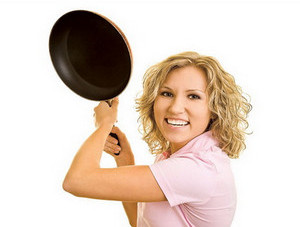
To ruin a Teflon frying pan, you will have to try: food practically does not stick to the non-stick coating. If you are one of the exceptions, remember: you cannot use abrasives (including cleaning powders), steel wool or brushes to clean Teflon cookware. Do not expose dishes to sudden temperature changes.
- First, fill the pan hot water, add a couple of drops of dishwashing gel or 2-4 tbsp. spoons of baking soda (alternative: 1 tablespoon of soda ash). After half an hour, rinse the dishes. Usually the “blackness” goes away without requiring additional measures.
- If you need to clean a Teflon frying pan from carbon deposits on both sides, use soda ash. Pour water (3 liters) into a basin, add 50 grams of soda and 150-200 ml of dish gel. Immerse the “affected” container in the composition and boil for half an hour.
Ceramics and aluminum
“Capricious” ceramics prefer special means, intended for such coverage. Besides, ceramic coating does not tolerate well cold water and hard sponges.- If the stains are small, “walk” over them with a rag soaked in medical alcohol.
- In more serious cases, use boiling, already familiar from previous methods: pour a little water into a frying pan, add a few drops of Fairy, boil for half an hour - the carbon deposits will easily wash off.
Aluminum does not like rough metal brushes and certainly does not tolerate dishwashers— such treatment causes the metal to darken and lose its performance properties. Cleaning methods:
- Gently, without intense rubbing, treat the outer and inner walls of the pan with a paste made from warm water and baking soda.
- As alternative option Boil water with a couple of tablespoons of soda in a bowl (30 minutes is enough).
- I wonder what to wash aluminum frying pan Toothpaste and an old brush will help remove carbon deposits. After cleaning burnt areas, rinse the dishes thoroughly.
How to clean a frying pan from old carbon deposits
The methods described are suitable for any coating:- Coarsely grate 1/2 block laundry soap, pour into a frying pan, add water and “cook” the soap solution for 30-40 minutes. Let the container stand for at least an hour, repeat the procedure, but with clean water.
- Fill a 10-liter bucket (tank, basin) with water, add 100 ml of silicate glue (PVA glue will also work) and 150-200 grams of baking soda. Immerse a frying pan in this mixture and “cook” for half an hour. Remove carbon deposits only after the dishes have cooled completely.
- Try cleaning an old burning frying pan with oven cleaner (the most common is Schumanite). You can apply the composition in a thick layer to the blackened areas, place the container in a sealed bag and leave overnight. In the morning, don’t forget to thoroughly wash the shiny new frying pan with a soft sponge.
On 04/14/2015
How can you easily make cast iron cookware “Teflon”?
Cast iron cookware is an unsurpassed champion in the quality of cooking - fried potatoes, pilaf, baked bread, pizza, borscht, porridge, chicken tabaka, etc. are obtained ideally due to thermal inertia and uniform distribution heat flow. But cast iron cookware fell out of use due to two serious shortcomings- food sticks to cast iron + cast iron rusts (note that the massiveness of cast iron cookware is not a disadvantage, but an inevitable property, just like all zepter-like inertial vessels with the same properties).
It turns out that you can get rid of these shortcomings of cast iron by yourself, for mere pennies, restore your cast iron cookware and in one day make it ideal, with a beautiful, environmentally friendly protective anti-corrosion and non-stick coating better than Teflon:
The secret is very simple - you need to apply a thin layer of drying vegetable oil to clean hot cast iron (linseed, hemp, poppy seed, walnut, tung are suitable, but in no case sunflower or olive!), then carefully heat the dishes. That's all!

Depending on the quality of the cast iron surface, 2-3 coats may be required. Fans of cast iron restoration manage to apply up to 20 layers, achieving mirror shine and deep black color.
Before moving on to the description of the process, we note what this gives us:
- food will never stick to cast iron cookware again and everything will go like clockwork in the truest sense of these words;
— unlike Teflon, which is perceived with caution by some due to the possible release of harmful compounds, only natural food ingredients are used here;
— unlike Teflon coating, which, if damaged, cannot be repaired on its own, here you can “heal” scratches at any time and apply additional layers;
- you don’t have to wash the dishes, you just need to wipe them with a paper napkin (in Soviet times, pans that were not yet cooled down were wiped with newspapers) and then, for control, wipe them with a napkin moistened with a drop sunflower oil. If the control napkin is clean, you can fry some sweet pies immediately after the fish, there will be no smell;
— the coating turns out to be moisture-heat-resistant and during cooking or steaming it can only fade temporarily, so you can also forget about rust forever.
You will need to do the following:
1. clean the dishes from soot (an old layer of burnt food and burnt fat) or from factory paint/oil if the cast iron cookware is new;
2. clean the dishes from rust;
3. Apply anti-corrosion agent to clean, dry, hot cast iron non-stick coating- grease the cast iron with drying oil (linseed, hemp, poppy seed, walnut) and carefully calcine it in the oven.
There are three things to remember when working with cast iron: important features:
— cast iron does not tolerate very sharp heating and cooling and can crack;
— cast iron is a porous material;
— the real color of cast iron that you should strive for when cleaning dishes is gray:
NATURAL COLOR OF CAST IRON

COLOR AFTER 1-2 LAYERS OF OIL

1. cleaning cast iron from carbon deposits/factory oil
Cast iron cookware can be cleaned of carbon deposits with alkali (oven cleaner) or pyrolysis - burning off organic residues, which leaves only ash. This can be done by firing on a fire, gas or electric hotplate, but it’s most convenient to use an electric oven in self-cleaning mode.
The intensity of the smoke and smell during burning depends on the amount of soot, but in any case, you need to take care of good ventilation of the room, and even better, do this not at home but in the country.
We remind you once again that cast iron can crack if it is heated sharply (subjected to temperature shock). Jack Hinkle, an experienced cast iron restorer and author of articles on the method, has carbon-charred over 700 cast iron skillets and cauldrons of priceless antique and personal value in his oven (some of the skillets are so precious and rare that they are worth tens of thousands of dollars!). He writes that firing cast iron in an oven is completely safe and if you find a crack AFTER firing, it means that it was there BEFORE firing, and was simply invisible under a layer of burnt fat and dirt.
If there is an option for length of self-cleaning time, then set it to at least 2 hours. Then the cleaning will end, but the door will still be closed with an automatic lock until the temperature in the oven drops from 600-700 C to 100-250 C, depending on the brand of the oven. When the lock opens, leave the dishes in the oven to continue to cool slowly until room temperature(you can do it with the door open to make it faster). When the cast iron has cooled to 30-40C, you can brush off the ash and begin removing rust.
2. Cleaning from rust
If there is very little rust, you can clean it off with a metal utensil cleaner with abrasive powder; if there is a lot, treat it with sandpaper or a wire brush. After mechanical cleaning recommended chemically suppress all possible pockets of rust, remembering that cast iron is porous. Acids will help us here. Sometimes vinegar or oxalic acid(a component of descaling and cleaning products), but it is most convenient to use phosphoric acid as a proven means for cold phosphating of ferrous metals.
Orthophosphoric acid is the main component of preparations that can be found using the keywords phosphating impregnation for metal, anti-corrosion rust converter, phosphating rust modifier for treating steel, cast iron, galvanized and aluminum surfaces before application paint and varnish materials. Orthophosphoric acid creates a protective layer against corrosion by converting rust into a protective phosphate film (cold phosphating), forming a chemically bonded layer of insoluble phosphate salts of iron, zinc and manganese. If someone is confused by the technical purpose of such products, we can recommend two ways - either buy pure phosphoric acid, or use drinks like Coca-Cola, Pepsi and the like, containing the approved food additive E338 - this is the very same orthophosphoric acid, which is called an “acidity regulator” or acidifier. If heated slightly, enough Coca-Cola will remove all the rust.
After removing the rust, you need to wash off the remaining acids from the cast iron in clean warm water, turn on the oven to maximum (usually 250C in household ovens) and, while it is not yet heated, immediately put the cast iron there. After the cast iron has warmed up with the stove and is guaranteed to dry out, you can proceed to the application procedure and begin calcining it with drying oil.
3. Applying a protective non-stick coating of drying oil to cast iron cookware.
Drying oils, unlike all other vegetable oils and animal fats, form a hard film when dried, like varnish, like enamel. So in a frying pan you need to heat the same drying oil that you will also find in the oil paints that painters use to paint their pictures, and after a while the paint dries forever on the canvas and it becomes hard and shiny. And, of course, painters use the same drying oil in paint when they paint walls, metal, and wood. oil paint dries to a shiny, durable coating that is smooth to the touch.
There are several edible drying oils you can find in grocery stores: flaxseed, poppy seed, butter walnut and tung nut oil (tung). Any of them will create a beautiful smooth black coating on the surface of the cast iron, and if you apply more than 5 layers, it will also be shiny. And if the frying pan is smooth, and you apply 20 layers, then in the bottom of the frying pan you can look at yourself as if in a black mirror.
You can use ordinary drying oil from a building materials store, but only natural, consisting of linseed oil with the addition of turpentine, and not drying oil-like products made from sunflower oil with white spirit, i.e. finding oil is not a problem.
After the cast iron has been heated to absolute dryness for an hour at a temperature of 200-250C, it is removed and greased with a drop of drying oil on the grate. If the cast iron is very smooth, then a drop will be enough for a whole frying pan.
Only if the handle has intricate parts and grooves, it will be possible to apply more oil there with the tip of a rag or a brush made of natural bristles (the frying pan is hot, you cannot use a synthetic brush).
It is extremely important to apply the oil in a thin layer so that the cast iron is almost dry and shiny. If you smear oil on cast iron so that it looks “wet,” it will dry out in patches and then may “flake.” In fact, a few are better. thin layers butter than a few thick! Therefore, we wipe the excess dry before calcining the freshly applied layer.
Then you need to put the oiled cast iron in a hot oven and calcinate it at the maximum temperature, which for household ovens is about 250C.
Why in the oven? You can, of course, calcinate it over an open fire, on an electric or gas burner, but in this case it is difficult to maintain the temperature regime - you can either burn the oil or underdry it, but in the oven this process is more convenient. There are adherents of natural drying in the sun, on outdoors, where ventilation is intense and ultraviolet radiation contributes to polymerization. But this process is long, akin to art, and not everyone will be able to use it, so calcination in the oven is the easiest and most reliable way.
The duration of calcination depends on the oil used. For example, tung oil polymerizes in 30 minutes, but linseed oil needs to be calcined longer: 1 hour, then turn off the oven and leave to dry for two hours at a decreasing temperature.
To apply the next layer, heat again to maximum, lubricate, leave for an hour, cool for two hours, etc. During this time, the coating on the cast iron will brown and become completely dry to the touch. Or, on cast iron of a different quality, different age, porosity and composition, it will remain practically unchanged. But already the third and fourth layers of calcined oil will completely change appearance and the quality of the coating inside and outside of cast iron cookware. The fourth layer is a deep black chocolate color.
Now in cast iron that has been well calcined with oil, you can long years cook anything, including baking, boiling, frying, and grilling. The only thing that cooking and braising in cast iron will do, says Greg, author of a wonderful blog about cast iron utensils, baking and cooking in it, is that the protective layer may tarnish. But shine, of course, can be easily restored by calcination with several layers of oil, if shine is so strongly needed for aesthetics.
source apxiv.ucoz.ru
Cast iron frying pans are still very popular among many housewives, since it is in them that dishes turn out especially tasty. But often cleaning such dishes is not easy. To keep your cast iron frying pan clean, you can use store supplies or use home cleaning methods. Let's take a closer look at how to care for and clean cast iron cookware.
Features of cast iron cookware
Recently, non-stick frying pans have become very popular. Even a less experienced housewife can cook dinner with them. The good thing about this type of cookware is that you can use it to prepare dietary dishes with a minimum amount of oil. But Teflon frying pans have one significant drawback - if the non-stick coating is damaged, cooking on them becomes hazardous to health. The same cannot be said about cast iron frying pans. This cookware is durable and quite easy to care for. It's no secret that this is the kind of cookware that professional chefs choose. A cast iron frying pan is ideal for cooking dishes that require long simmering over a fire. Due to the low thermal conductivity of cast iron, the pan heats up slowly and cools down as well, which allows food to cook evenly, without burning. Due to its impressive weight, the cookware stands firmly on the stove and does not move when stirred.
Due to the fact that cast iron has a porous structure, over time a frying pan made of this metal acquires additional protective properties. Therefore, the deposit formed with outside, not so scary. But with inside The frying pan will still have to be cleaned regularly - carbon deposits on the walls can ruin the taste of the cooked food. But be prepared for the fact that after cleaning, food will start to burn on the cast iron frying pan. This is not scary - the problem is completely solvable. It is very easy to restore the non-stick layer, and this is another undoubted advantage.
When buying a cast iron frying pan, remember that this metal is quite brittle and can crack from a strong impact. In addition, with prolonged contact with water, a cast iron frying pan may rust. In order for cast iron cookware to serve you for decades, it needs to be properly cared for.
How to clean the inside walls of a cast iron frying pan?
To remove carbon deposits inner part frying pans, you can use several methods:
In the frying pan you need to pour regular table salt or baking soda. The main thing is that the layer of salt or soda completely covers the soot. Next, place the pan on the fire and heat it for at least 3 hours. If the carbon deposits do not fall off after calcination, you can lightly rub the frying pan with sand.
The second method is faster. To clean, you will need half a pack of soda. Pour it into a frying pan and fill it with water. Then put on fire, bring to a boil and wait 30 minutes. After this procedure, clean the frying pan with a stiff brush and rinse with cold water.
The third method is similar to the second, only instead of soda you use salt and vinegar.
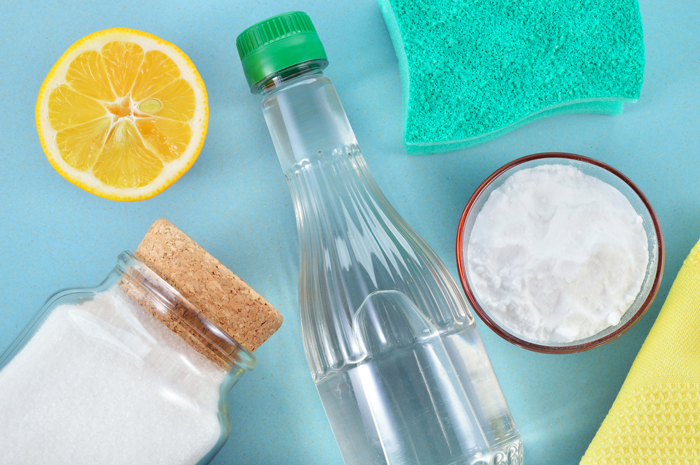
In addition to these three methods, there is one more, proven over the years. It is suitable for removing the heaviest carbon deposits. However, it is worth knowing that this method has an extremely negative impact on protective covering cast iron frying pan. After such cleaning it will have to be restored. So, to clean the frying pan, you need to take:
- A large metal container that can accommodate the frying pan.
- A medium sized pack of soda ash. You can take caustic (the same amount) or regular food grade (2 times more).
- Stationery silicate glue (2-3 bubbles are enough).
The cleaning process is as follows:
Place the frying pan in the prepared container and fill it with water. If the container is large enough, then you can also put other dishes that need high-quality cleaning there;
Add all ingredients to water;
Bring water to a boil;
After 30 minutes of boiling, you can turn off the gas and remove the dishes;
Rinse the dishes using a regular sponge under running water.
If you don’t have caustic soda at home, or you don’t want to expose your frying pan to such a serious impact, then you can take soap shavings and PVA glue for boiling. Only in this case you will have to spend more time - boiling should last at least 2 hours.
As already mentioned, carbon deposits on the outer walls of cast iron cookware are not dangerous. But sometimes it happens that during cooking the frying pan begins to smoke. In this case, it still needs to be cleaned. The most common method by which carbon deposits can be removed is roasting. At high temperatures, all greasy deposits burn out and are very easy to clean off with a wire brush. But remember that only cast iron cookware can be cleaned this way. An aluminum frying pan may melt due to such actions, and a Teflon frying pan will lose its protective layer. In order to get rid of soot in this way, you can use several methods:
After using the firing method, the frying pan must be greased. It could be a piece of lard or any vegetable oil. After lubricating the walls, wipe with a cloth and keep the pan on the fire for a few minutes.
The above methods do not always help remove carbon deposits. They may not be able to cope with the most corrosive contaminants. Then you have to clean the frying pan mechanically. A small one is suitable for this. sandpaper or cleaning powder. If available, you can use a sanding machine, which will greatly simplify the matter. A metal brush is also suitable for mechanical cleaning.
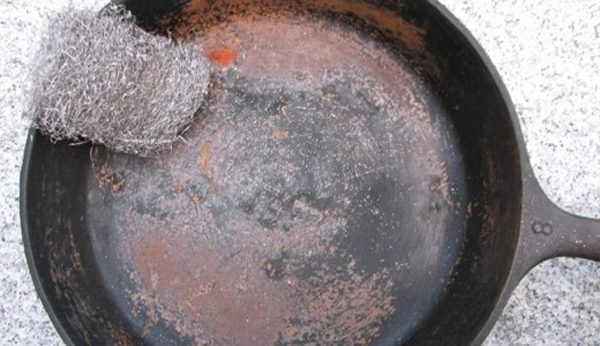
Chemical cleaning method
Clean a cast iron skillet with chemicals only possible outside. Cast iron is a porous material. Chemicals can clog these pores, and it will be impossible to cook food in such a frying pan. In addition, chemical detergents may destroy the protective layer of the frying pan.
The most famous cleaning products for cast iron cookware are “Shumanit” and “Antinagar”.
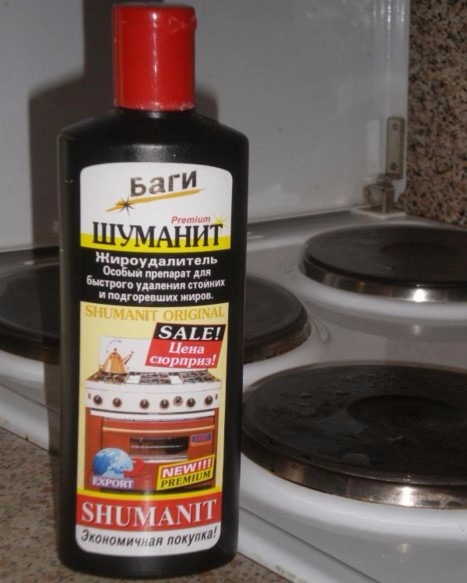
"Shumanit" is able to cope with the most persistent stains in just 1 - 2 hours. To do this, spray the product on the outer walls of the cast iron frying pan. After the required time has passed, the frying pan can be easily washed under running water using a sponge. “Shumanit” will also easily clean the walls and racks of the oven. When working with this product, you must follow safety rules: wear gloves, open windows and turn on the hood.
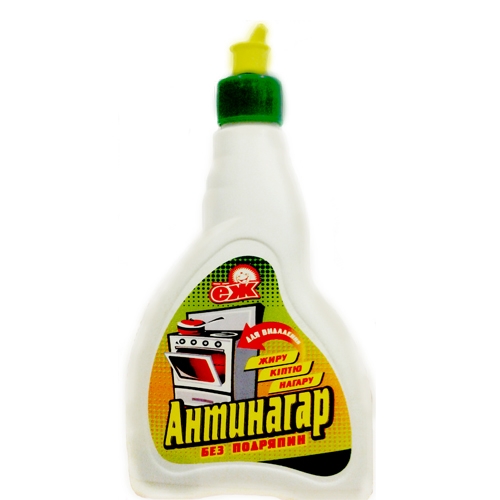
"Antinagar" is a whole range of products produced by Russian and foreign manufacturers. Before applying Antinagar domestic production, the frying pan needs to be heated. After the product is applied, several hours must pass for the deposits to begin to move away from the walls of the cookware. In order to properly clean the frying pan, you will have to apply the product several times.
In addition to the above chemistry, carbon deposits from outside Cast iron skillets can be cleaned with oven cleaner. It also copes well with difficult stains.
Rust control
Cast iron cookware can rust easily. This happens if after washing you do not wipe it dry, but immediately put it in the closet. Rust may appear on the surface and if too long-term storage cooked food in it. If you notice characteristic red spots on your frying pan, proceed as follows:
Treat the rust with fine sandpaper;
Rinse the frying pan under running water and dry thoroughly;
Grease the walls with oil and heat the frying pan on the stove.
Proper care of any utensils is the key to it long service. And cast iron utensils are no exception - although they are durable, poor care can significantly shorten their lifespan. So how to properly care for cast iron cookware?
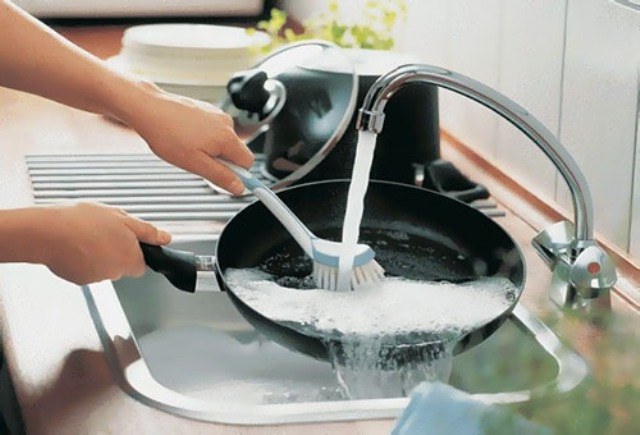
- To clean a cast iron skillet, use only hot water and a sponge. It is not advisable to use cleaning powders or liquid dishwashing detergent - this will damage the protective layer.
- After washing, the dishes should be dried immediately.
- After the food is cooked, it must be transferred to another container, as long-term storage can lead to the formation of rust.
- If a foreign odor emanates from a cast iron frying pan, pour salt into it and heat it over the fire.
- Remember to create a new protective layer on your cast iron skillet if it has been extensively cleaned or if liquid food has been cooked in it.
How to prepare a new cast iron frying pan?
If you have just purchased cast iron cookware, do not rush to start cooking right away. First you need to carefully inspect the frying pan. High quality tableware will be black. This means that the factory has already created a base protective layer, and you only need to take care of the non-stick coating. If the surface gray, then you will have to create the base layer yourself.
In order to create a base layer on a cast iron frying pan at home, you must adhere to the following algorithm of actions:
- The inner walls of the frying pan are greased with oil and then wiped thoroughly.
- The frying pan prepared in this way should be placed on the stove or in a preheated oven. The temperature at which the base layer is created should be in the range of 180 - 240°C (it cannot be higher, otherwise all the fat that was used to lubricate the walls will burn out).
- Keep the frying pan on the stove for 30 minutes, in the oven for about an hour.
- After the allotted time has passed, you will see that a dark layer has appeared on the surface of the pan.
- To create the base layer, the entire process must be repeated twice more.

After the base is ready, they move on to creating a non-stick coating.
How to create a non-stick coating?
To create a non-stick coating you need to do the following:
- Pour about 1 cm of vegetable oil into the pan.
- Place the dishes on the fire or in the oven. Temperature the same as when creating the base layer. Pay special attention to this, as it can cause too much high temperature the oil may begin to burn (smoking from heated oil is allowed).
- As you do this, constantly brush the inner walls of the pan with heated oil (a silicone brush is suitable for this).
- After 30 minutes, drain the oil and wipe the pan dry.
Now your cast iron frying pan is completely ready to use. Cook with pleasure!
Not a single housewife can do without the problem of soot on the frying pan. At least for modern markets and there is a large assortment of different detergents and cleaning products, but even they are not always able to cope with the task of cleaning the frying pan from grease and soot.
Types of frying pans
In order to get rid of carbon deposits, you need to know the types and materials from which frying pans are made.
- A cast iron frying pan is considered the heaviest and highest quality. They are often inherited from grandmothers and accumulate a lot of fat on themselves.
- The Teflon product, which has a non-stick coating, is already equipped with non-stick protection and easy cleaning. But it does not guarantee the complete absence of burnt soot on the outside.
- Stainless steel and ceramics require very careful cleaning with special products.
It’s worth talking about how to remove scale from a specific type of pan.
Modern cleaning products
Today humanity cannot imagine its life without household chemicals. But it is worth remembering that you need to use it correctly. For example, not every person knows that some products are very difficult to wash off from the surface with ordinary water.
Experts recommend using such substances in minute quantities when cleaning burnt pans. The ideal means are considered trade marks“Fairy”, “AOC”, “Sanita”, “Gala” and “Silit”. When working with these chemicals, you must follow certain rules: use special rubber gloves and a respirator. In addition, do not forget to ventilate the room using a hood or windows.
How to properly clean frying pans from accumulated fumes
Before you start cleaning the product from carbon deposits, it is worth understanding what it is and how it is obtained. Soot is a layer of fat that forms as the pan heats up. It usually quickly settles on the wall of the product, both inside and outside. Such layers, accumulating over the years, are a real nightmare for lovers of cleanliness, accustomed to the shine and shine of dishes.
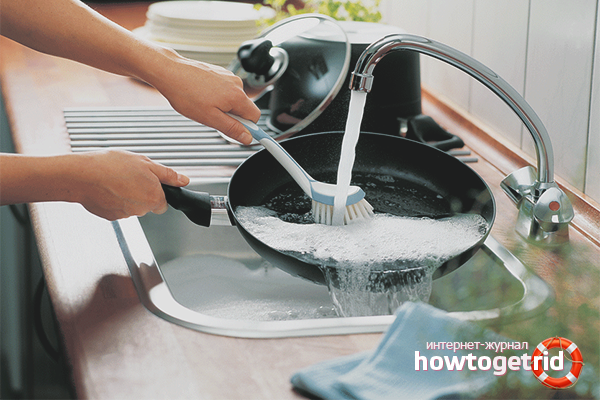
If household chemicals cannot cope with the problem, then you can try other cleaning options:
- An aluminum frying pan must not be washed with products that contain abrasive particles. Also, do not rub it with metal brushes. Here it is appropriate to use baking soda and a soft cloth.
- The non-stick coating is also resistant to aggressive household chemicals, which often damage Teflon. And if the coating is even slightly scratched, the product can be thrown away. Owners of such a frying pan are recommended to boil it in a unique solution. To prepare it, take 200 grams of dishwashing detergent, 3 tablespoons of soda and dissolve them in a bottle of heated water. Mix everything well and leave on low heat. Then put the frying pan there and boil it for about 30 minutes. Then safely take it out and rinse with running water.
- When using Teflon products, do not use metal objects. In addition, try not to expose them to temperature changes: do not put them in cold water immediately after cooking.
- Stainless steel has a big disadvantage: food burns in it. But if you purchased beautiful product, then ordinary salt will correct the situation. In order to remove food residues from the coating, you need to sprinkle half a glass of salt on the bottom of the pan and leave to soak for several hours. After such actions, the plaque will be easily removed from the product. If you have baking soda on hand, you can use that too. This product is also used for cleaning other utensils: bowls, mugs and pans.
- A frying pan made of stainless material is well washed by activated carbon, carefully crushed and applied to problem areas. It is recommended to pour a little water on top of the coal and leave for 20 minutes. Then all you have to do is wash off the solution along with the carbon deposits using a stiff brush.
- Experts recommend washing ceramic frying pans by professional means using soft cloths. After you have used such a product for the first time, you should wipe it with a salt solution, rinse it with running water and wipe it with a dry cloth. If you want to use your favorite ceramic frying pan for a long time, then never put it in cold water to soak burnt-on food.
The most difficult task in the kitchen can be called cleaning old cast iron pans. Due to their excellent quality, such products last for decades. The downside here is the carbon deposits that accumulate for a long time outside. The layer of fat, over time, becomes very hard and difficult to remove. There are several reliable and effective ways fight against soot, inherited from our grandmothers:
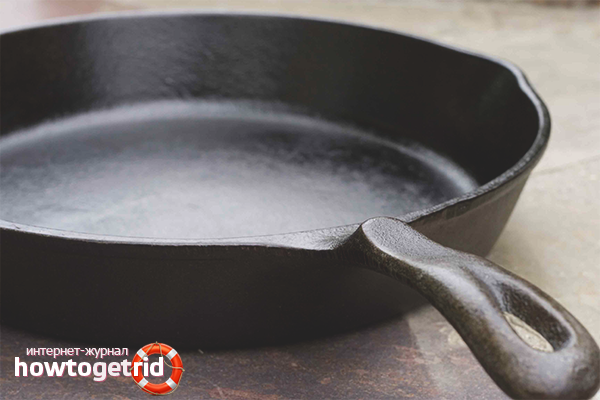
- Cleaning the fat layer with high temperatures. In order to put this method into action, you need to place the frying pan on the fire and burn its sides with gas. Craftsmen manage to perfectly clean the product using blowtorches and grinding machines. These are quite effective options, but it is recommended to practice them in an open space and not in your kitchen.
- The following solution is considered good: 100 grams of laundry soap shavings, 0.5 kilograms of soda and 100 grams of silicate glue. All ingredients are mixed with 10 liters of water, poured into a wide bowl and put on fire. Place a frying pan here and boil for about 30 minutes. After this, turn off the gas, cool the solution, remove the product and rinse it with tap water. Such actions guarantee that the fumes will remain in the water and the frying pan will become like new.
- An easier option for cleaning cast iron is a sand sauna. Take a frying pan, pour a layer of sand into it and place it on the fire. Leave the product on the fire for 3 hours. This method saves you from tedious cleaning, but has a distinctive disadvantage - a specific smell.
- Try taking 1 glass of vinegar and 3 glasses of water, mix them and pour them into the product for 5 hours. Constantly monitor the water level in the pan. Such cleaning does not require much physical effort, but it will not benefit your sense of smell. To avoid poisoning from vinegar fumes, be sure to turn on the hood or open the windows. If the cast iron begins to smell like vinegar after cleaning, then treat it with a solution of soda, using the boiling method.
- Buy a pack activated carbon, crush it and soak it in water. Sprinkle the pan with this product, and after an hour, wash it with dishwashing detergent.
As mentioned above, aluminum products should not be rubbed with rough sponges or abrasive cleaning agents. Ideal option Soda is considered to be good at removing the fat layer inside and outside the product.
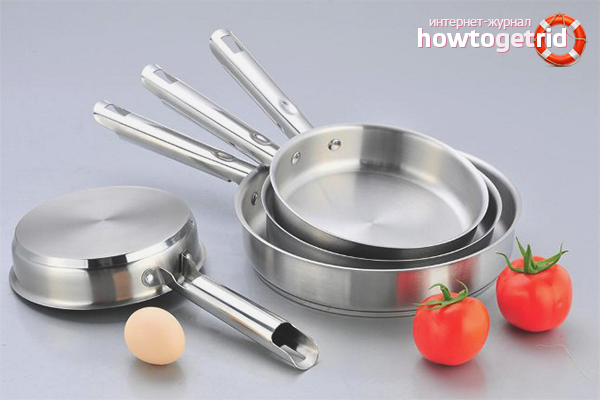
Apply baking soda to a soft cloth and gently rub the surface of the pan with it. If this option is not acceptable to you, then you can boil the vessel in a soda solution for about 30 minutes.
How to clean pans in dishwashers
Women really like this method, because you just need to put the frying pan in the machine, turn it on the desired function and go about your business. The dishwasher will automatically remove carbon deposits from your dishes. The cycle can be repeated several times as needed.
All cleaning methods are good, but still, try to take care of the product on time so that problems do not arise during its use.
Video: cleaning a frying pan from carbon deposits using plain water

Every housewife is faced with the fact that over the years her kitchen utensils lose their external beauty, which is hidden under a layer of soot. Even with careful care, darkening of the outside of the walls of the pans remains inevitable, which upsets many who are not used to parting with their favorite kitchen items. And this article will be useful precisely to such housewives who want to know how to clean a frying pan from carbon deposits at home.
The layer of oil and fat that is deposited on the outside of the pan, called soot, sticks to the surface when exposed to high heat. Therefore, without knowing the specifics, how to remove it, return it beautiful view kitchen utensils will not work.
Not surprisingly, the pan gets dirty the fastest. Every housewife uses this item several times during the day. Stewing and frying immediately make themselves felt upon completion of cooking, even if the scrupulous housewife uses special dishwashing detergents. You can find out below what to do in such situations and how to wash the frying pan from carbon deposits.
 Conventional detergents will not help in the fight against carbon deposits on the walls of the frying pan. In such cases, "heavy artillery" should be used. These are chemicals and preparations that contain special carbon cleaning agents. They can be applied to cast iron and the outer walls of Teflon pans. But it’s better not to try to clean aluminum utensils chemicals. If you apply harsh chemicals to such metal, it can be damaged, which can affect cooking if the interior has been treated.
Conventional detergents will not help in the fight against carbon deposits on the walls of the frying pan. In such cases, "heavy artillery" should be used. These are chemicals and preparations that contain special carbon cleaning agents. They can be applied to cast iron and the outer walls of Teflon pans. But it’s better not to try to clean aluminum utensils chemicals. If you apply harsh chemicals to such metal, it can be damaged, which can affect cooking if the interior has been treated.
Basically, such products are applied in the same way according to the instructions, despite the fact that their manufacturers may be different.
The chemical composition, which is designed to clean the layer of burnt fat on the walls of kitchen utensils, should be applied for several hours.
During this time, the cleaning composition should penetrate deep into the thick layer of oil and dissolve it. As a rule, such products are presented in the form of a gel or spray containing acid. Therefore, when using such compositions, you should be especially careful, avoiding contact with skin and eyes.
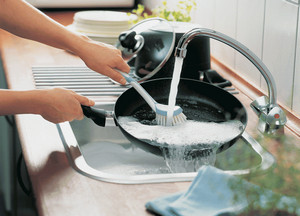 Sometimes at home, housewives come to the aid of chemical agents that have a different area of action. For example, some housewives with experience have gotten used to using compositions that are aimed at cleaning toilets. Among the components contained in such products, there are stronger substances that are extremely dangerous for the skin, but at the same time quickly cope with “sore” areas and soot. The main thing is that after using these products on utensils intended for cooking, thoroughly wash the surface. At the same time, do not forget about safety precautions, and before cleaning the frying pan from carbon deposits, wear protective gloves.
Sometimes at home, housewives come to the aid of chemical agents that have a different area of action. For example, some housewives with experience have gotten used to using compositions that are aimed at cleaning toilets. Among the components contained in such products, there are stronger substances that are extremely dangerous for the skin, but at the same time quickly cope with “sore” areas and soot. The main thing is that after using these products on utensils intended for cooking, thoroughly wash the surface. At the same time, do not forget about safety precautions, and before cleaning the frying pan from carbon deposits, wear protective gloves.
Using “folk methods”
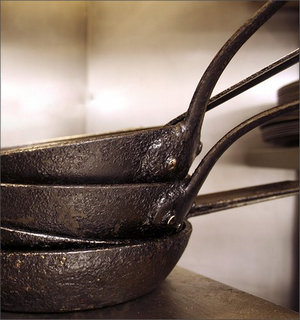 There are more humane ways, how to clean a frying pan from carbon deposits using primitive products at home. Similar methods are no less effective. Moreover, by resorting to one of these, you can reduce the impact of the remaining chemicals on the body.
There are more humane ways, how to clean a frying pan from carbon deposits using primitive products at home. Similar methods are no less effective. Moreover, by resorting to one of these, you can reduce the impact of the remaining chemicals on the body.
Clean utensils with salt
This “grandmother’s” method is considered the most accessible. Housewives use it, as a rule, in frying pans made of of stainless steel which have lost their marketable appearance.
To make this kitchen item shine again, you need to take about 0.5 cups of table salt and scatter it in an even layer along the bottom of the container. After a few hours, carbon deposits can be easily removed under running water.
Soda will help
By  You can use regular baking soda to remove a layer of burnt fat from an aluminum frying pan. This product, unlike chemical ones, will deal with carbon deposits on this metal quite gently and quickly. You just need to pour a small amount of powder onto a washcloth or piece of cloth and rub the “problem” areas of the utensil. The result will not be long in coming, the dishes will become clean and will not be damaged.
You can use regular baking soda to remove a layer of burnt fat from an aluminum frying pan. This product, unlike chemical ones, will deal with carbon deposits on this metal quite gently and quickly. You just need to pour a small amount of powder onto a washcloth or piece of cloth and rub the “problem” areas of the utensil. The result will not be long in coming, the dishes will become clean and will not be damaged.
Sand "bath"
 This method will tell you how to clean cast iron frying pan from carbon deposits on the outer walls. To experiment with this method, you will need regular sand. We fill cast iron utensils with it, which we then place on low heat. On average, 2.5-3 hours are enough to heat sand. If you need to clean an old frying pan, it may take much longer.
This method will tell you how to clean cast iron frying pan from carbon deposits on the outer walls. To experiment with this method, you will need regular sand. We fill cast iron utensils with it, which we then place on low heat. On average, 2.5-3 hours are enough to heat sand. If you need to clean an old frying pan, it may take much longer.
At the end of the procedure, the sand is removed from the dishes, and the container itself is tapped wooden hammer. As a result, without special effort you will be able to get rid of a layer of fat. However, be prepared for the fact that while heating the sand, a not very pleasant smell will spread throughout the kitchen.
Digestion
 Previously, housewives used this method at home quite often, as it is effective. To clean the outside of a cast iron frying pan, you will need:
Previously, housewives used this method at home quite often, as it is effective. To clean the outside of a cast iron frying pan, you will need:
- large basin or pan;
- a bar of laundry soap;
- 250 gr. soda ash;
- 100 ml silicate glue;
- water.
At the beginning of the procedure, place it on the stove in a basin and pour water into it. Turn on medium heat, and while the water is heating up, grate the soap. Then in warm water place the resulting shavings, pour in soda and pour out the glue. The mixture should be brought to a boil, stirring constantly. When the water becomes hot, you need to reduce the heat and place the frying pan. It will take from 30 minutes to 2 hours to boil, depending on the degree of contamination. Having taken out the utensils after the specified time, you will notice that the layer of fat has almost completely dissolved. Remaining carbon deposits can be removed with steel wool, rinsing the dishes under running clean water.
Extreme Cleaning
 To clean kitchen utensils from carbon deposits, many housewives resort to more drastic methods. For example, a blowtorch will be effective in combating burnt layers of oil and fat. However, having decided to use this option When cleaning a frying pan, it is worth knowing that it is not suitable for ceramic cookware and Teflon-coated appliances. In general, a blowtorch is great if you need to clean an old frying pan that grandma got from you.
To clean kitchen utensils from carbon deposits, many housewives resort to more drastic methods. For example, a blowtorch will be effective in combating burnt layers of oil and fat. However, having decided to use this option When cleaning a frying pan, it is worth knowing that it is not suitable for ceramic cookware and Teflon-coated appliances. In general, a blowtorch is great if you need to clean an old frying pan that grandma got from you.
For use blowtorch In order to remove carbon deposits from the outer walls of utensils, it is better to go outside.
It is advisable that the place where you plan to carry out the procedure is remote from chemicals and foreign flammable objects. After processing the dishes is completed, the remaining carbon deposits should be removed with a wire brush. After this, the container must be thoroughly rinsed under running water.
Cleaning with a dishwasher
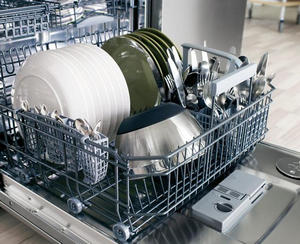 Happy owners of dishwashers can use another method to clean a frying pan from carbon deposits. The fact is that these household devices have a mode for removing a layer of stuck-on fat. Just place the kitchen utensils in the machine, turn on the mode and wait until the machine automatically cleans the dishes.
Happy owners of dishwashers can use another method to clean a frying pan from carbon deposits. The fact is that these household devices have a mode for removing a layer of stuck-on fat. Just place the kitchen utensils in the machine, turn on the mode and wait until the machine automatically cleans the dishes.
However, there are also some nuances when using household appliances of this kind. For example, it is not recommended for cleaning carbon deposits on ceramic frying pans turn on modes with sudden temperature changes. Also, do not experiment with coarse abrasives on this utensil.




